Thunder Mushrooms In A Coconut Curry (Gud Gud Alambe Ambat/Randayi)
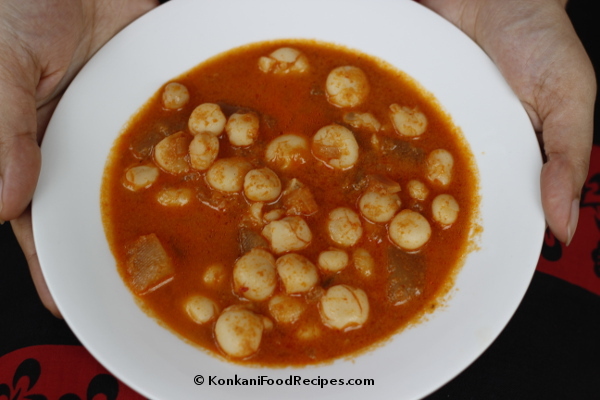
Western ghats of coastal Karnataka receives heavy rainfall. And to the people of coastal Karnataka rainy season brings lots of treats along with plentiful showers. Nature blooms and blossoms and we get to enjoy nature’s bounty. It gets green all around and there’s abundance of everything! Including rain. :-)
Like many Indian cuisines, Konkani cuisine includes all kinds of wild but edible fruits, leaves, barks, stems, flowers & roots that are foraged and are made into mouth-watering delicacies.
One such nature’s treat are these tiny mushrooms that grow only during the start of monsoon each year. These mushrooms are called alamb in Konkani.

These mushrooms grow just below the ground, in the hilly areas, near the coastal regions of Udupi-Mangalore. These mushrooms are different from the regular mushrooms & they say they can't be cultivated. These mushrooms are totally round in shape and do not have any stem. These mushrooms grow only in the wild, amongst thick forests, amidst decomposing leaves. They rarely grow up to the size of a lemon and they come in all shapes & sizes. They have an outer, soft or hard, thin, sometimes thick covering. And hence, are peeled to get the inner, edible, soft, white portion. The soft inner white part is then cooked to make yummy Konkani delicacies. For the most part, they are bland in taste. Hence, they're used to make spicy Konkani preparations like a spicy coconut curry with field marrow & onions, called as alamba ambat/randayi/gashi in Konkani. Or are used to make alamba sukke/bhutti, a spicy, coconut based side dish. Or are used to make alamba sanna polo - spicy, tiny rice dosas for lunch, with these mushrooms in them.
Freshly bought mushrooms, uncleaned mushrooms look like these:
In the picture below (clockwise) are freshly brought mushrooms, cleaned, washed mushrooms, peeled mushrooms (the edible, inner, soft part of the mushroom) and mushroom peels on the left.
Peeling these mushrooms: The hard or soft, thin, sometimes thick, outer skin is carefully removed without breaking the inner, soft, white, edible portion.
The peel is thrown away & only the inner, white, edible part of mushroom is used in cooking.
Below are the outer sheels/peels & some with the edible white part in them.
Peeled, white, edible part:
These mushrooms are available only for a month and a half during the start of monsoon season every year. Hence, they are highly sought after by the Konkani community.
It is believed that these mushrooms grow in abundance when it thunders and lightens. Hence, these mushrooms are also called as gud gud alambe/alamb in Konkani. Alambe/alamb in Konkani means mushrooms and gud gudu means lighting in Konkani. Hence, the name, thunder mushrooms.
Some of these mushrooms tend to get spoilt on the inside (the reason is unknown, aging, storing them for few days spoils them, cleaning them & storing, spoils them instantly. Cleaning removes their mycelium I guess. :) ). Mushrooms could be partly spoilt or completely spoilt, you know it by the change in colour of the inner, white, edible portion you get after peeling. The inner, pure white, edible portion changes to light brown or dark brown or black in colour. You could chop off those portions and use rest of the mushroom. But please do not use those mushrooms that are completely blackened/brown on the inside. The mushrooms might look good from the outside, but if the inner portion is completely brown or black, throw away such mushrooms.
Peeling off these mushrooms is a tedious process. Removing the outer shell requires time and patience. You need to use your nails or sharp end of a spoon or a knife or something sharp to deshell them and in the process keep the inner, soft, edible portion intact & whole. They could easily break off or get crushed with little pressure applied. Keeping these mushrooms whole is the key to enjoying them later. And the whole process is laborious. With joint families in earlier days, peeling these mushrooms while it poured heavily outside during monsoon was fun. All my family members would gather around to peel these tiny mushrooms.
These mushrooms once peeled, considerably reduce in quantity. They further reduce in quantity on cooking. Hence, if you want to cook for 2 of you, you would need at least half a kg of these mushrooms. And peeling half a kg of these mushrooms should take anywhere between 30-60 minutes depending on your skill. :-) However, once cooked they taste absolutely amazing. So, it’s worth the effort. These mushrooms cook fast and they take only about 5-7 minutes to cook. While they're cooking they give out an odour which might be a little unpleasant to ones who are new to these mushrooms.
As these mushrooms are seasonal, they're highly sought after by the Konkani community. So, they're very expensive. But as with anything, Konkani’s don’t give a damn when they love eating something. :-) Just like the bibbo/tender cashews and anything else for that matter.
We prepare a wide variety of dishes with these mushrooms. We prepare spicy coconut based curries with these mushrooms and Mangalore cucumber, called as alambe randayi/ambat in Konkani. We make spicy side dishes called as alamba bhutti/sukke in Konkani and side dishes, gravys called as alambe song in Konkani. We also make spicy, rice based savoury pancakes called as alamba sanna polo in Konkani.
These thunder mushrooms are called by various local names - bhuyiphutil (it means emerged from the earth in Konkani), gud gud alambe (means thunder mushrooms in Konkani), kall alamb (means stone shaped mushrooms in Konkani). In Kannada they are called kall anabe (kallu means stone and anabe means mushroom in Kannada)
Ingredients to make the curry (alamba randayi/ambat/gashi):
- Half a kilo thunder mushrooms/gud gud alambe.
- 3/4 cup grated coconut
- 1/2 of a medium-sized Mangalore cucumber/Field marrow
- 3 medium sized onions
- 1 tablespoon/lemon sized tamarind
- 5-6 dried red chillies
- 4 tablespoons of oil
- Salt to taste
Serves: 2
Preparation Time: 60 minutes including the peeling time.
Preparation Method:
1. Give the mushrooms a good wash and peel them all carefully. (Refer steps mentioned above)
Use your nails or the back of a spoon or a knife or something sharp to deshell them and in the process keep the inner, soft, edible portion intact & whole. They could easily break off or get crushed with little pressure applied. Keeping these mushrooms whole is the key to enjoying them later.
2. Peel and cube the Mangalore cucumber.
3. Peel and finely chop 1 medium sized onion.
4. Cook together Mangalore cucumber, chopped onion and peeled mushrooms using 1.5 to 2 cups of water and salt.
5. Cook until they are cooked through and keep them closed.
Cooked thunder mushrooms look like these:
6. Peel, finely chop the other 2 medium sized onions and keep them aside.
Preparing the masala for the gravy:
7. Heat a tempering pan, add in few drops of oil and fry the dried red chillies for 2-3 minutes. Remove them from heat and let them cool completely.
8. Grind them along with tamarind and grated coconut into a smooth paste using as much water as required.
9. Add the ground masala to the cooking vessel containing cooked mushrooms, onions and Mangalore cucumber. Mix well.
10. Check and adjust salt.
11. Add water if required. The consistency of the curry should be medium thick in the end. It'll thicken as it cooks & further thicken on cooling. So, keep it a little watery to begin with.
12. Bring the curry to boil.
13. As the curry comes to a boil, heat a tempering pan. Add in all the remaining oil, add in chopped onions and fry them until they start to brown.
14. Add this to the boiling curry and let the curry simmer for 2-3 more minutes, until the rawness of the masala goes off.
15. Remove off heat and serve the curry hot with a bowl of steaming hot rice for lunch, dinner. Or serve this delicious curry with soft, fluffy black lentil dosas (udha polo) for breakfast.
Side Note: If you want to add thickness to the curry, add in half a cup of cooked toor dal to the boiling curry.
For more Konkani cuisine curry recipes look here.
Tags: Konkani cuisine, Konkani food, Konkani recipe, Alambe, gud gud alambe, alamba randayi, alamba ambat, alamb, bhuyiphutil, kall alamb, kall anabe, Udupi cuisine, Mangalore food
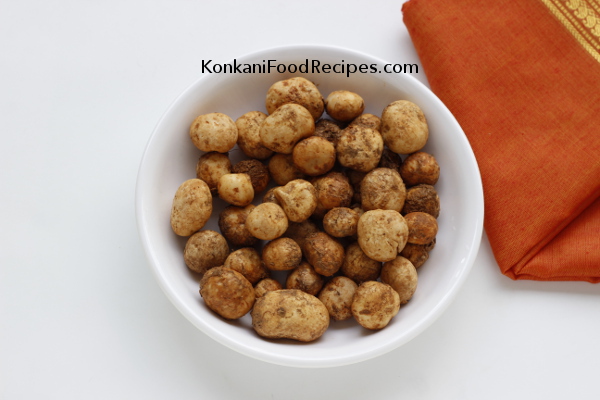



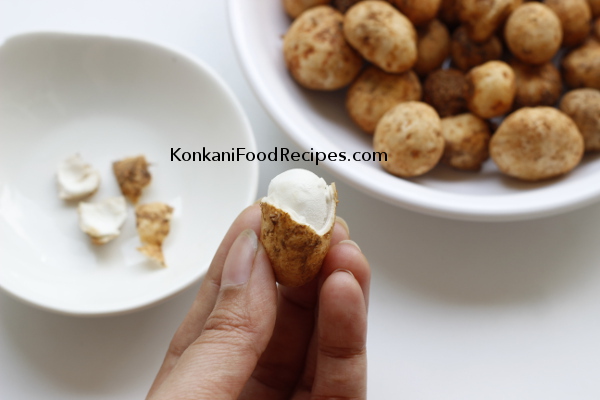
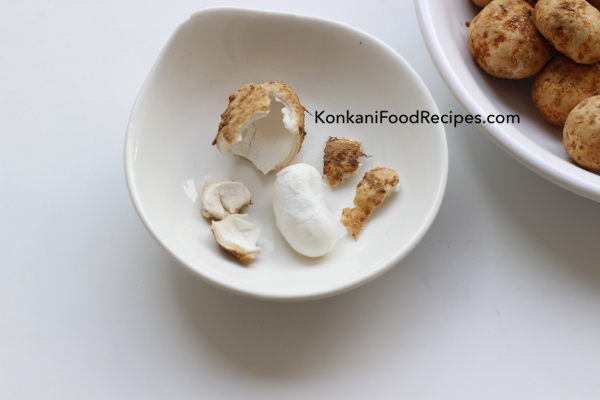




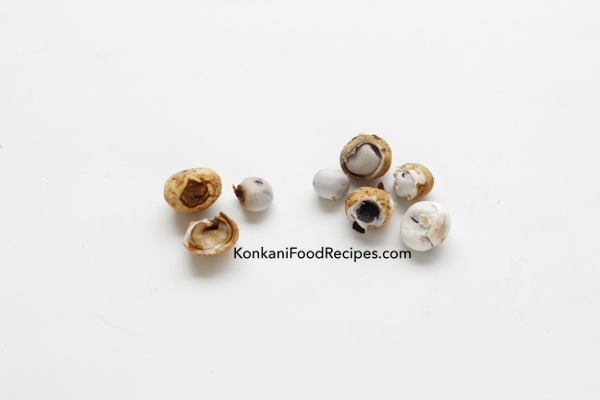
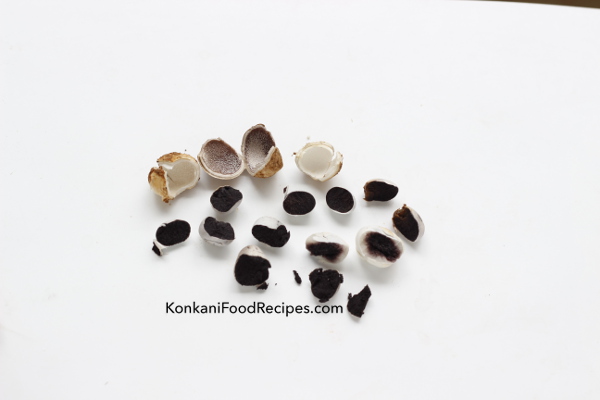
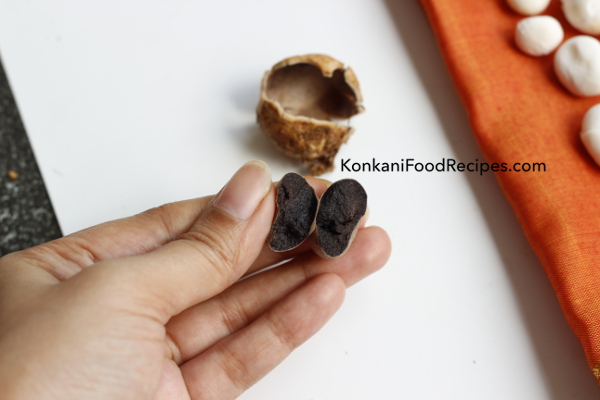
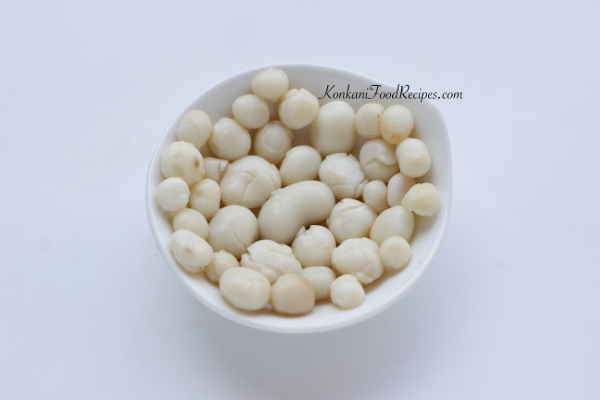
Tweet